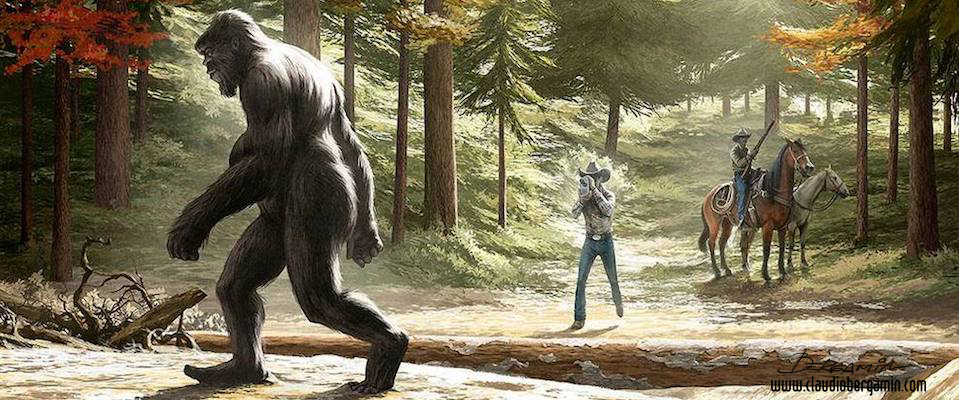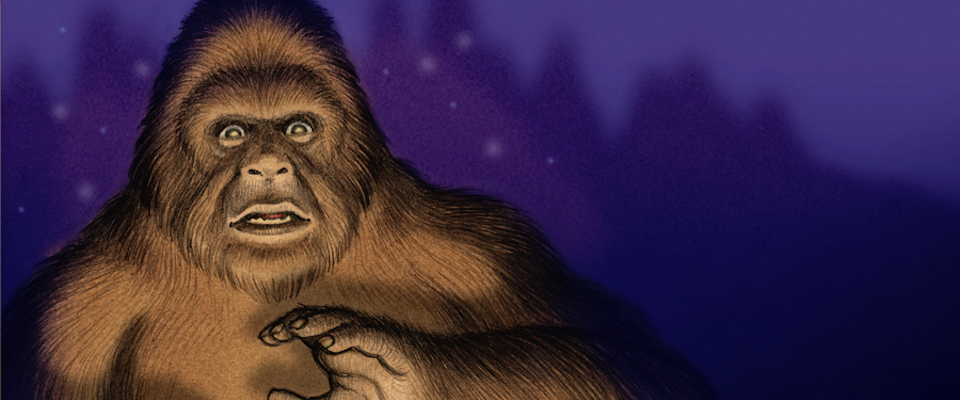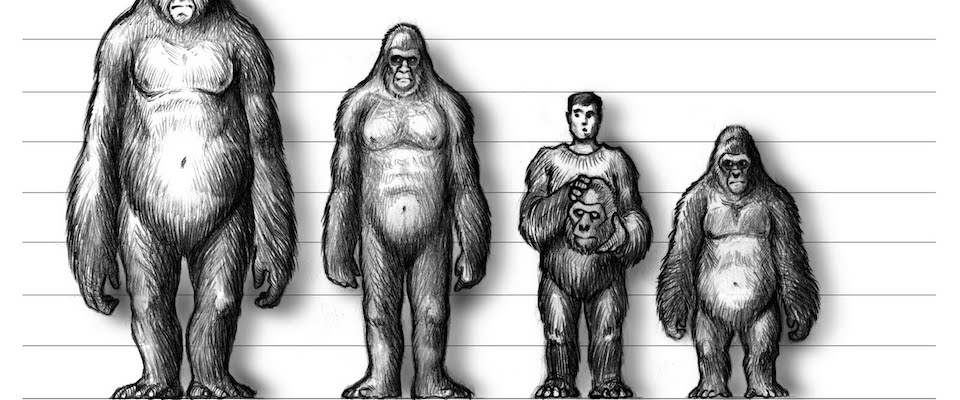Last week, we published a two-part profile on UC Berkeley grad and anthropologist Grover Krantz, known to many as the original “Bigfoot scientist.” (You can find the first part of the profile here and the second half here.) Today, we examine the question of whether mythological creatures like Bigfoot are worthy of scientific analysis. The answers we discovered might surprise you.
It’s difficult to get respect when you work in a field that is referred to as pseudoscience.
Cryptozoology, the study of animals as yet undiscovered, relies heavily on folklore, citizen accounts, and amateur data collection to “prove” that legendary creatures like Bigfoot and Yeti actually exist. In the absence of empirical evidence—and of the skepticism intrinsic to scientific inquiry—such methods can be troubling if not irritating to mainstream scientists.
However, there appears to be some agreement among academics that creatures of folklore deserve scientific investigation. Why? Because cryptid studies have long led to discoveries.
“Through the history of time, there have been things that were once perceived outside of nature that were then brought into it and understood to be a part of nature,” said Cal grad and folklore professor Lynne McNeill, in an interview with Radio West. “I think that a lot of this interest in the science, or pseudoscience, of [creatures like] Bigfoot—is in crossing that bridge, bringing something unknown into the known.”
Take, for example, the giant squid.
Since Greek and Roman times (and probably before) people have been telling tales of a terrifying, tentacled sea monster of titanic size that could swamp small ships and sailboats, scaring sailors while providing fiction writers with a plethora of material. The giant squid was considered nothing but a fiction by the scientific community for centuries until 1857, when Danish zoologist Japetus Steenstrup managed to find a squid beak so enormous that it could only belong to a cephalopod of jumbo proportions. “From all evidences,” Steenstrup concluded, “the stranded animal must thus belong not only to the large but to the really gigantic cephalopods, whose existence has on the whole been doubted.”

Following this, bits and pieces of the giant squid were found by others—a batch of tentacles here, a head there, but no complete body. It wasn’t until the 1960s that marine biologist Frederick Aldrich would harness the power of folklore to transform myth into reality, dragging to science’s doorstep the first fully intact body of the KRAKEN.
Using the folktales from Memorial University of Newfoundland’s archives, Aldrich collected sailors’ descriptions of where and when they saw the creature, then predicted when the next sightings would occur. He put up WANTED, DEAD OR ALIVE posters featuring old black-and-white drawings of a giant squid flailing its monstrous tentacles, with the University of Newfoundland’s name at the top. “It’s a miracle he didn’t get fired,” McNeill said. Two weeks later, a sailor caught a giant squid, called Aldrich up and said, “Oh, hey. Here it is!”
“The people saying, ‘Here it is!’ are of course poor fisherman living on the coast of Newfoundland, who all along are the ones who were finding these pieces and body parts, saying the giant squid was real, and being totally discredited because they weren’t university professors,” McNeill said. “Of course, this is the sad story of people not being taken seriously until a university professor takes them seriously. But, better that than never, right?”
And the giant squid is not the only case.
The gorilla was thought to be fake until the 19th century, when naturalist and physician Thomas Savage happened upon gorilla bones in Liberia, finally proving that the species was real. It then took another 10 years for explorer Paul du Chaillu to actually see a gorilla, hunt it down, and send back the specimen. The platypus, okapi, Komodo dragon, manatee, plesiosaur, pelican, and the King of Saxony bird of paradise, among others, were only “officially declared real” by scientists after the 1700s, which means for the 18 centuries before that, they were considered to be mythical or hoaxes.
From these cases we can surmise that mysterious animals don’t reveal themselves only to scientists; they can in fact be pretty apathetic about what audience bears witness to their debut. And it is certainly consistent with scientific inquiry to believe that just because a creature is not known now doesn’t mean it never will be. Cryptozoologists often use this reasoning to justify paying heed to civilian accounts of Bigfoot sightings—an idea that even the world’s foremost expert on chimpanzees, Jane Goodall, would seem to get behind.

“Does Sasquatch exist? There are countless people—especially indigenous people—in different parts of America who claim to have seen such a creature,” writes Goodall in her endorsement of Sasquatch: Legend Meets Science, a book by Idaho State University professor and anthropologist Jeffrey Meldrum. “And in many parts of the world I meet those who, in a matter-of-fact way, tell me of their encounters with large, bipedal, tail-less hominids. I think I have read every article and every book about these creatures, and while most scientists are not satisfied with existing evidence, I have an open mind.”
If the search for Sasquatch doesn’t result in finding a literal Bigfoot, studying cryptids has been shown to lead to discoveries of previously unidentified species. And recently, too.
In 2013, a documentary film company enlisted the help of Charlotte Lindqvist, a geneticist at the University at Buffalo in New York, to help determine whether the bone and fur samples they collected in the Himalayas were that of Bigfoot or Yeti. Though Lindqvist found that the samples were not from cryptids but were actually from multiple known species of bears, the samples allowed for scientific breakthrough of another kind: Lindqvist and her colleagues were able to, for the first time in history, fully sequence the mitochondrial genomes of a Himalayan brown bear and black bear. Not only that, but they were also able to deduce that over 650,000 years ago, glaciers forced a single population of bears apart, creating two isolated populations that, over time, became two distinct subspecies—the Himalayan brown bears and Tibetan brown bears that exist today.
In the same year, scientists from Oxford University and zoological museums in France and Germany put out a call asking people to send them evidence of “anomalous primates” like Sasquatch. When it was all said and done, they had 57 hair and fur samples, and almost all of them were from previously discovered mammals like black bears, dogs, cows, porcupines, and horses. However, two different samples from Bhutan and India matched a 40,000-year-old fossil of a polar bear found in Norway, though neither sample matched genetic markers in modern polar bears. Meaning that the search for cryptids led scientists to discover a species of bear that was previously unknown to science—a species that may have been in existence even before polar and brown bears diverged into different species.
“There’s a lot of pigheadedness about scientists,” said Krantz in an article about Bigfoot. “If science has missed an animal this big, science would look a little funny. So better not look for it.”
Norman MacLeod, curator of paleontology at London’s Natural History Museum, said the results of this research prove that scientists and cryptozoologists need to cooperate.
“Cryptozoologists must now either accept the findings … or show where they are in error,” MacLeod writes in his review of the Oxford University study. “Mainstream zoologists must also now recognize that, in the case of hair samples, the claims of the cryptozoological community are now amenable to scientific testing and potential verification. In this area, these two communities can and should speak the same language, the language of hard scientific data and hypothesis testing. Will this ultimately lead to the recognition of new large mammalian species in out-of-the way corners of the world? No one—certainly no scientist—can say for sure. What we do know is that scientific discoveries just as strange and unexpected as those advocated by cryptozoologists in these cases have happened before.”
So if history shows that science can potentially benefit from examining cryptozoological findings, why is that so many scientists are still adamantly against the practice? Berkeley graduate Grover Krantz, the first scientist to publicly dedicate his life and career to the search for Bigfoot (and whom we profile here and here) thought the problem for many of his colleagues is their hurt pride—they can’t bear the idea of having to admit a colossal creature like Sasquatch was right under their noses all this time.
“There’s a lot of pigheadedness about scientists,” Krantz told the Virginia Chronicle in a 1982 article about Bigfoot. “If science has missed an animal this big, science would look a little funny. So better not look for it.”
Another reason scientists don’t go public with their belief, Krantz said, is fear of being ostracized—something he knew about quite well. While working as a professor at Washington State, he was constantly turned down for grants and promotions and was almost fired multiple times for investigating and speaking openly about Sasquatch.
Krantz estimated that 10-20 percent of scientists actually do believe in Sasquatch, according to a 1978 story in the Desert Sun, but they’re afraid to come out as believers and risk their careers.

“[Scientists] continue to be for the most part skeptical,” Krantz said in a 1990s TV segment. “But there’s a substantial number who do think [Sasquatch] is real, and some who do take the possibility quite seriously.”
Of course, stubbornness and fear aren’t the only reasons that scientists might turn up their noses at cryptozoology. The search for Bigfoot is rife with elaborate hoaxes that could make anyone’s eyes roll. Some cryptozoologists have fallen prey to these hoaxes, accepting photo or video footage as evidence that a creature exists—something scientists would never do.
“Cryptozoology wants so bad to be a real science; it really wants to be recognized. You know, [cryptozoologists] have their own journals, they give talks, they hold their own conferences. And a lot of it is science-ish … but they don’t hold themselves to the same standards as actual scientists,” science journalist Brian Switek said in an interview with Radio West. “They don’t act professional is the thing. It can be easy for that line to get blurred. What is actually science? How are these people actually testing this? Is this just someone who really wants this to be true and is just finding a way to express their belief in this mildly technical language?”
A famous example of this is the Patterson-Gimlin film, the supposed first known footage of a Bigfoot traipsing through the woods of Bluff Creek in the late 1960s. Scientists who watched the film immediately after its release deemed it totally bogus, and years later in a National Geographic interview, a man named Bob Heironimous publicly claimed that the film was all a hoax, and that filmmakers Bob Gimlin and Roger Patterson promised him a grand if he’d put on a suit and pretend to be Bigfoot. They never paid him, he said, and for years, he kept silent about it until he apparently couldn’t take the injustice anymore.
“Those who would seek monsters not as metaphors, but as flesh and blood organisms have gone largely overlooked by the history of science,” says Brian Regal. “Belief in Bigfoot has become a part of the rejection of knowledge”
“Millions of people have been fooled, all these years,” Heironimous said. “If they had paid me the $1,000 like they promised, I would have kept my mouth shut.”
Regardless, Bigfoot believers still look to the film as proof of Bigfoot’s existence. Even Krantz who, for reasons of his own, became convinced it was real—despite having originally dismissed it as “someone wearing a gorilla suit.”
Despite all this, it would seem inappropriate, if not illogical, for scientists to be vehemently against studying cryptids, not just because it’s yielded good results in the past, but also because forbidding the study of something goes against the entire principle of the scientific method, as the scientists of the 2013 Oxford University study note.
“Modern science has largely avoided this field and [cryptozoological] advocates frequently complain that they have been ‘rejected by science,’” the scientists write in their paper. “This conflicts with the basic tenet that science neither rejects nor accepts anything without examining the evidence.”
It’s also undeniable that without the data collection and research of determined amateurs, science would not likely have discovered many of the creatures we know today. Not recognizing the value of cryptozoologists, says Kean University professor Brian Regal, would be strikingly unjust.
“Those who would seek monsters not as metaphors, but as flesh and blood organisms have gone largely overlooked by the history of science,” Regal writes in the philosophical and scientific journal Endeavor. “Belief in Bigfoot has become a part of the rejection of knowledge all too many Americans engage in over the pronouncements of ‘experts.’”

No matter how much science pulls back, McNeill says, those hunting for cryptids like Bigfoot will leave no footprint uncast.
“It is, these days, taboo in many ways to say science might not have gotten it right. Science is our new religion, right? We could say, ‘God will it,’ and now we can say, ‘Science determined it,’” McNeill says. “And that’s the model we live in now. But people have not stopped wondering … and any time that our institutions don’t take on the question or provide us with answers, or provide us with answers that are satisfactory, people turn to more informal levels of cultural exchange to get their questions answered.”
The irony of all this, of course, is that the pursuit of truth is what cryptozoologists and scientists have in common, yet also appears to be what divides them. “The pursuit of truth leads people to both believe in legends,” McNeill says, “And to totally denounce them.”
If you enjoyed this piece, check back in tomorrow, when we investigate why and how people come to believe in legendary animals like Bigfoot and the Loch Ness Monster. The reasons for their beliefs, Berkeley experts say, might even be rational.
Krissy Eliot is senior associate editor at CALIFORNIA. You can find more examples of her work and her contact info at www.krissyeliot.com.






















